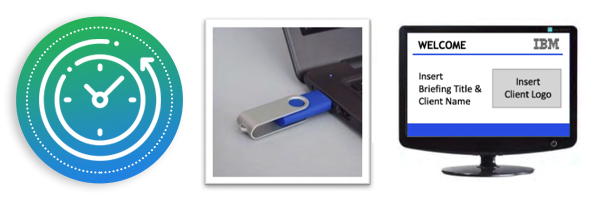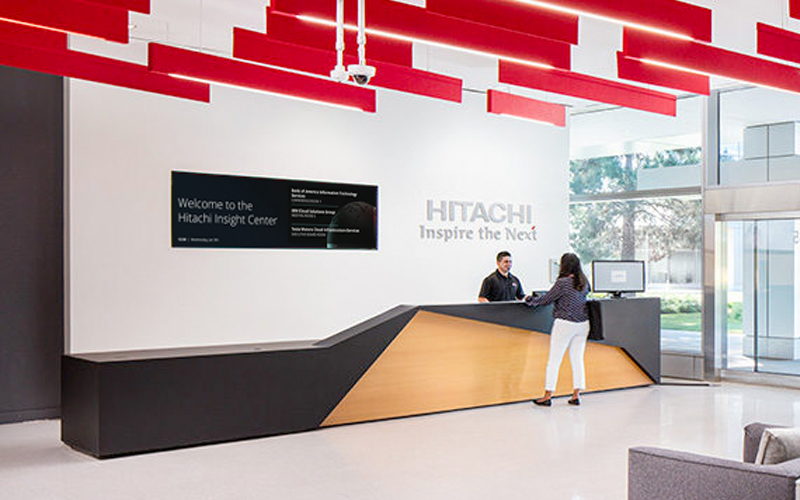During the 1990s, the executive briefing center industry started finding new ways to utilize digital screens. Comprised of a computer monitor with a PC hidden under the counter, clients entering a briefing room were greeted by name and dazzling logo animations. These played throughout the day, and all an operator had to do was type new entries every morning.
Nowadays, these types of systems have evolved considerably and integrated with large-format media walls and lights that showcase the visiting company’s branding. And since briefing centers have become the most important spots for enterprises to impress customers, leads, and partners, and for testing high-end marketing tactics, it’s easy to see why digital presentation technologies have become so prevalent.
To make the most of these technologies, center programs started hiring full-time technologists for maintenance purposes and troubleshooting issues during briefings. Furthermore, they help with upgrading and integrating future technologies so that they work flawlessly with existing systems. Now, we’ll take a more in-depth look into how basic digital personalization has transformed the briefing center industry.
Signet: A Key Player From The Beginning
We mentioned earlier that the 1990s was a pioneering period for digital personalization. But did you know that Signet played a major role from the beginning by helping evolve this technology? Well, we worked with a program that had a staff member tasked with changing customer name and logo information on a computer in PPT, which was connected to a display by the reception desk. But this method had several glaring flaws that we decided to resolve.

After several briefings, the staff member kept getting caught in traffic or had to stay home due to illness. Therefore, it wasn’t always possible to update customer information and logos on time for all briefings. Signet had to come up with a more dynamic solution that allowed our client to schedule these changes a day before or a full week ahead.
Enhancing The Customer Journey
At an early stage, it was easy for briefing center programs to ascertain their investments in content management systems. These would pay off in terms of risk management, especially as to how it relates to coordinating the customer journey and staff time. Since it only takes around 20 minutes for a staff member to make the necessary changes, it’s a relatively affordable investment for most enterprises.
But center programs started understanding how a digital display network could form in their centers doing more than a simple customer welcome screen. There’s now a greater focus on integrating the customer journey while speaking to the brand. Moreover, it’s easier to provide solutions in various areas in the center where their customers would be throughout the day.
Also, consider what an impressive feat it was back in the late 1990s and early 2000s for enterprises to showcase their annual brand videos for customers to view. Yet programs understood that they could work with other teams in the enterprise within their reach, to attain new event material, marketing collateral, and other digital assets for their content management systems. To keep things fresh, they’d schedule this content to play randomly so that the same video isn’t playing over and over again, which is, unfortunately, still the case for some centers.
The Next Stage Of Digital Personalization
Technology is always evolving, and we witnessed automation and integration come to the forefront during the 2010s. Programs started utilizing more advanced scheduling systems, and industry solution providers saw that as the perfect opportunity to create hooks into their content management systems to pull in data such as the customer company name, briefing start and end times, and logo images. Now, it takes no extra time to schedule content based on the staff’s current workflow.

Between 2010 to 2019, there’s been a boom in the creation of APIs that integrate with a program’s scheduling system and digital signage. Signet still hears of cases surrounding a center’s visiting executive or political figure that takes a group picture or selfie in front of an enterprise’s logo on the welcome screen. Soon after that, the picture is posted on a social platform such as LinkedIn, which is a huge source of organic traffic and presents excellent brand marketing opportunities.
In Conclusion
In the past 20 years, digital personalization has transformed the briefing center industry considerably. Signet has been there since the beginning, witnessing the advent of these technologies, and helping them evolve with our input. Today, we stand on the cusp of further innovations that help enhance the customer journey in briefing centers around the country.

